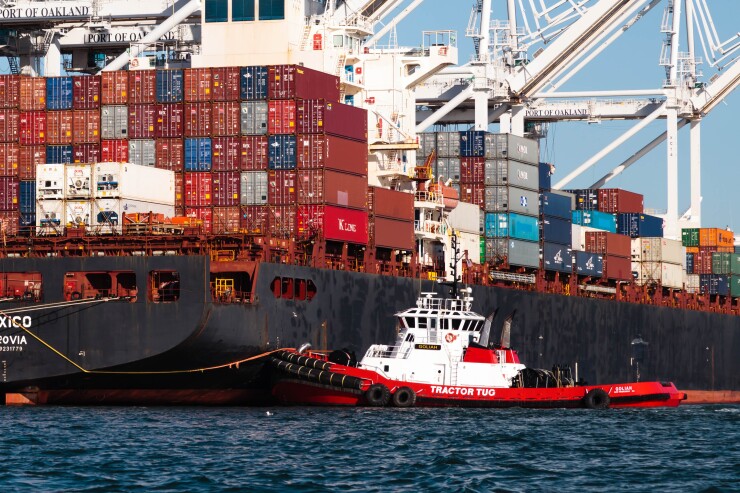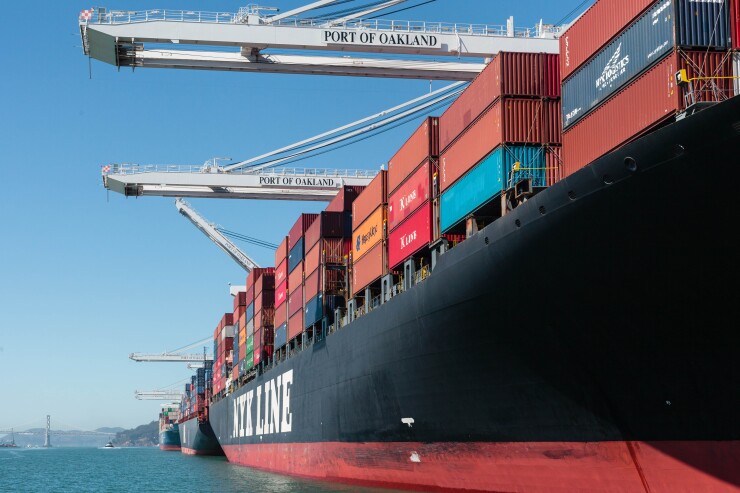West Coast port volumes climbed to historic highs as concern over planned tariffs and anticipated price increases on Chinese goods drove U.S. shippers to stockpile goods.
Now port officials are bracing for a drop in volume in the new year, even after the Trump administration and Chinese trade officials agreed Dec. 2 to resume talks and postpone further tariffs.
Credit quality at most ports is closely tied to container volume, so frosty relations with a major trade partner has the potential to hurt. Analysts had already expected a delayed reaction to the trade war, as Moody's Investors Service explained in a recently published piece.
"Our expectation of lower volume growth in 2019 reflects the fact that some shipments were front-loaded into 2018, ahead of planned tariff increases," Moody's said.
While Moody's said the outlook for ports generally was stable going into the new year, it could turn negative if tariff battles escalate.
"An escalation of the trade dispute between the US and China remains the key risk," the agency said.
The Trump administration had threatened in November to ratchet up trade tariffs on $200 billion of Chinese goods to 25% from the current 10% by January 1, but backed off those plans in early December pending continued talks.

The White House and Chinese officials announced on Dec. 2 that they would resume talks with a focus on removing all U.S. tariffs and Chinese retaliatory tariffs. A deadline has not been set, but White House officials have said if the talks should fail the federal government would move forward on stiffer tariffs.
U.S. President Donald Trump on Dec. 3 appointed U.S. Trade Representative Robert Lighthizer to lead trade talks. Lighthizer, viewed as a protectionist, replaces Treasury Secretary Steven Mnuchin in that role.
Imports into U.S. seaports had been surging over usual seasonal patterns through November in an push by retailers and manufacturers to pull orders forward ahead of the new round of tariffs that were slated to hit in Jan. 1, according to the California Business Roundtable.
The West Coast Basin Container Terminals and Everport Terminal Services handled the biggest ships to ever call at those facilities in October, Port of Los Angeles Executive Director Gene Seroka said in a statement.
The Los Angeles port has been seeing larger and larger vessels and every port across the country has been seeing increases in imports, said Phillip Sanfield, a Port of Los Angeles spokesman.
“But things could drop off considerably the rest of the year, because a lot of cargo that would have come through the ports in January and February came in October through December to try to beat the Jan. 1 deadline,” Sanfield said.
Ports in southern California, Georgia and Virginia reported double-digit growth in import volume from September to October, setting monthly records as furniture, apparel, auto parts and other goods streamed in, according to the California Business Roundtable.

Though numbers spiked in October at the Port of Los Angeles, overall volumes for the first 10 months of the year showed a 1.1% increase to 7.7 million TEUS, compared with 2017 when the port set an all-time annual cargo record.
Through November 2018, loaded exports in 2018 are about 1.7 million TEUS, which is about the same as last year, Sanfield said.
Port of Los Angeles Oakland Maritime Director John Driscoll cited front-loading as part of the reason for the jump in imports at the northern California port. He also said the strength in the U.S. economy and the annual increase in holiday orders from importers were factors.
Oakland’s import volume rose 2.7% by late November over 2017, which was a record year for containerized cargo at the port. Imports from China have increased 5% this year, according to port officials. Exports to China declined 33% in 2018, which was attributed to tough new Chinese restrictions on wastepaper shipments, an Oakland export staple.
"We are pleased by our peak season figures," said Port of Oakland Maritime Director John Driscoll. "Now, we will see how tariffs affect future trade flows."
While Oakland’s China exports have declined, exports to other nations have increased. Export shipments to Vietnam jumped 96% in September and exports to Taiwan increased 37%, according to port officials.
The Port of Oakland reported in November that it is on track for its third straight year of record container volume in 2018; and that all West Coast ports are reporting unprecedented cargo volume growth since midsummer.
The consensus among the 40 trade and transportation executives that comprise the Oakland port’s Efficiency Task Force was that cargo volume is spiking right now, but could drop by January.
The task force reported that warehouses are filling up as U.S. retailers import merchandise from Asia at higher levels to prepare for price increases. Transpacific shipping lines have added more than 30 extra voyages involving larger container ships to transport higher container volumes.
Los Angeles has 1.8 billion square feet of warehouse and distribution space that is currently packed with goods, Sanfield said.
The UCLA Anderson Forecast economists said during their December forecast that a trade war between the U.S. and China and the Federal Reserves normalization of rates will dampen economic growth in 2019.
While California's economy has been evolving as expected, the risk of a trade war with China remains a concern, as it could adversely affect the logistics industry, one of the fastest growing sectors in California this past year, said Jerry Nicklesburg, director of the Anderson Forecast.
“With respect to trade it appears that we are in the process of entering into an economic cold war with China,” David Shulman, a senior economist with the UCLA Anderson Forecast, wrote in his December forecast. “President Trump is threatening to impost tariffs on up to 25% on all $537 billion in Chinese imports. At an average rate of 20%, that would amount to a $107 billion tax on the U.S. economy.”
Though most market participants “cling to the hope that a reasonable deal can be made,” Shulman wrote, “we would caution them to take careful note of the recent remarks made by Vice President [Mike] Pence and former Secretary of the Treasury and Goldman Sachs CEO Henry Paulson, a longtime friend of Beijing."
Speaking at the Hudson Institute, Pence said: "America had hoped that economic liberalization would bring China into a greater partnership with us and with the world. Instead. China has chosen economic aggression, which has in turn emboldened its growing military.”
Shulman called Paulson’s recent remarks in Singapore the most surprising, as he had long championed engagement with China, but recently noted that an “economic iron curtain” may soon descend resulting in a “long winter in U.S.-China relations and systemic risk of monumental proportions."
“In other words, both countries are playing with fire,” Shulman wrote. “In fact, China is already feeling the pain with slowing economic growth and a nearly 30% stock market decline. There are few winners in a trade war with lots of collateral damage.”
Shulman also questioned whether the Democrat-led House of Representatives would approve the USMCA Treaty that replaces the North American Free-Trade Agreement between the U.S. and Mexico, given that Democrats have not historically been free-trade oriented.
“Unless cooler heads prevail, our forecast is that the risks coming from the trade sector are all on the downside,” Shulman wrote.





